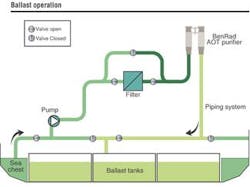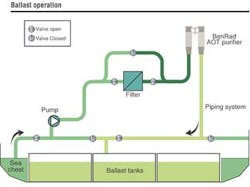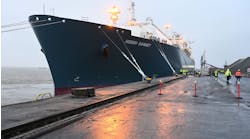Oxidation technique eliminates bacteria in industrial/potable water treatment systems
Process could also be extended to reservoir injection
Nick Terdre
Contributing Editor
Advanced oxidation technology (AOT) is a patented process from Stockholm- based Benrad that can solve water purification problems encountered offshore. Applications are wide-rang-ing, although the company's current focus is in marine and industrial process water, potable water, and cooling systems.
Schematic illustrates Benrad's ballast water treatment technique.
null
The process has been applied successfully on cruise ships in applications such as pool, Jacuzzi, and AC systems, lowering operational costs and reducing use of chemicals such as chlorine. Technical waters are another potential problem area onboard, particularly in engines where there is a risk of bacteria and bio-film growth and corrosion. Installing a Benrad system here can lead to a bacteria-free operation, in turn reducing maintenance.
The AOT process, introduced in 1997, exploits the synergy effect that arises from combining ultra violet light, catalysis, and ozone to create hydroxyl (OH) radicals. These are potent in breaking down microorganisms and bacteria, and react in the Benrad process within nanoseconds. No substances or side effects are introduced into the process, and no residuals are created. The redox potential of the OH radicals is almost double that of chlorine, which is still used widely in water treatment applications. Benrad-AOT has also proven effective against legionella and in the dissolution of bio-films, two phenomena that are considered extremely hard to treat.
Titanium is applied within the system's chambers to help the process function in most types of environment. The three base products in the range are the M300, M600, and M900. All are of a modular design, which allows them to be adapted to most capacity requirements.
The problem of bacterial growth has intensified as the chemical means used to combat it are being increasingly phased out. The AOT process, in contrast, is environmentally friendly, and can be used with all forms of water.
With potable water systems, it provides a beneficial alternative to traditional methods of treating the water, such as silver ionization, which has the drawback of adding heavy metal to the water, and chlorine, which gives the water an unpleasant smell and taste. It could also be applied to produce drinking quality water from the condensed water drawn from air conditioning units.
The AOT process is not primarily intended to combat corrosion in water systems, but can have this beneficial effect as it uses oxygen and reduces its content almost to zero in a re-circulation system.
Ballast water
Ballast water issues have come to the fore in recent years with the growing realization that the flora and fauna carried in the water can damage the native marine ecosystems in the area where they are discharged. The International Maritime Organization (IMO) is preparing regulations for ballast water treatment, which are due to be enforced in 2009.
Benrad has developed a ballast water treatment process in which the seawater undergoes pre-filtration via a back-flush filter, then passes through the AOT purifier before being pumped into the ballast tanks. On discharge it again passes through the purifier. Laboratory tests at the Kristineberg marine research station in Sweden showed that the process is able to meet the proposed IMO standards, achieving a 100% kill rate on bacteria and all plankton types, leaving no residuals or remaining toxicity.
Benrad has now been invited to take part in a test program to be run by the US Coast Guard as it prepares for the new regulations. It has also participated in the European Union's Martob program, one aim of which is to demonstrate methods for the on-board treatment of ballast water.
Injection water
The ballast water treatment system could be of interest to the offshore sector as a means of treating water for injection into oil reservoirs. The AOT technology is also applicable in other ways to offshore rigs and vessels. The M900 system, with 25 cu m/hr treatment capacity, would be suitable for use in the cooling system in a diesel-electric engine-room, and also in potable water systems. Each U-shaped unit is about 1 m tall and weighs 35 kg. Capacity can be easily increased by manifolding several units together. The power consumption for each unit is only 150 W. The M300 and M600, with 2.5 cu m/hr capacity, are suited for smaller capacity needs.
For more information, contact Peter Svensson, Benrad. Tel: +46 85 2272 231, fax: +46 85 2272 299, [email protected], www.benrad.com.




